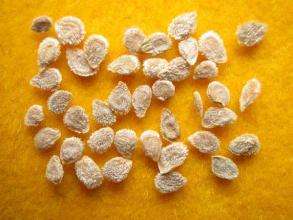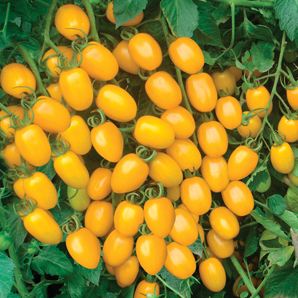Hwangkumbae is a Korean variety. The Korea Horticultural Experiment Factory has been a hybrid of the new sorghum centuries since 1967 and has been bred and named in 1984 after many years of breeding. This variety belongs to the P. pyrifolia Nakai system. It is a medium-late-maturing variety with good quality, early fruit, high yield, and strong resistance. It is a mid-late-maturing variety with excellent comprehensive traits. It can be harvested in mid-to-late September. Golden pear fruit shape, fruit shoulder level, fruit shape index 0.9. Non-bagging fruit skin is yellowish green and becomes golden yellow after storage; bagged fruit has yellow and white skin, small and uniform fruit spots, and the appearance is extremely beautiful; the flesh is milky white with small fruit nucleus; the edible rate is more than 95%, and the meat is crisp and tender. Fruit juices are multi-sweet and have sweet odor, few stone cells, high sugar content, sugar content 14.7 to 15.0, soluble solids 12% to 15%, Beijing area up to 18%, acid content 0.156%, average fruit weight 350 g, large fruit weight 500 g or more. The fruit and fruit leaves of this variety have strong resistance to black spot disease and black spot disease, but their resistance to dry rot is poor, and brown scald occurs easily during storage and transportation. The post-harvest fruit has high respiratory intensity, sugar consumption, and rapid degradation of VC. Using Golden Pear as a test material, the author studied the storage characteristics, key technologies of storage, storage and transportation diseases, and comprehensive prevention and control techniques of Golden Pear, which filled up the blank of storage and preservation of domestic gold pears, and resolved the texture of golden pears after harvest at room temperature. The problem of soft, short storage period, and serious losses, at the same time brings hope for the increase of income of farmers and satisfaction of consumer demand. The following is a brief introduction of its storage and preservation technology. 1 Storage characteristics of golden pear 1.1 Low-temperature storage storage The experimental study showed that the golden pear was frozen at -3 °C, and the optimal storage temperature was -1 to 0 °C. This temperature can effectively reduce its respiratory intensity and reduce nutrients. loss. Golden pears (on September 20) can be stored at room temperature (20 °C) for 10 to 15 days after harvesting. In the later period, the pulp has a large odor and is not edible. At low temperature (0 °C), supplemented with controlled atmosphere storage, but can be stored for 7 to 8 months, and some can even be stored until the new fruit market in the following year. 1.2 High-humidity storage Under higher humidity, the loss of fruit moisture is less, thus reducing the natural loss and keeping the fruit fresh. When the golden pear loses 5% to 7%, the fruit surface appears shrunken, which affects its appearance quality. Therefore, when stored at low temperature (0 °C), it needs to be packaged in fresh-keeping paper with a humidity of 85% to 90% (more than 90% of fruit weight loss, but easy to cause mold breeding). Research shows that this requirement can be met by using commercially available plastic bags with a thickness of 0.013 mm. 1.3 Atmospheric storage of golden pears can tolerate higher CO2, but when CO2 ≥ 5%, it is easy to cause CO2 poisoning (ie, peels and flesh appear brown cooking state). When the O22 content is insufficient (≤ 2%), it is easy to cause hypoxic injury. Therefore, the concentration of CO2 and O2 in the storage environment must be strictly controlled during storage of the pears in the atmosphere. 2 Golden pear storage technology points 2.1 Appropriate harvesting of Golden Pear in North China is suitable for harvest period from September 20 to 30. At this point, the fruit has matured and accumulated nutrients, and the best storage stability. Early harvest (September 10) Pear fruit has a high decay rate throughout the storage period and the peel is easily browned. It was harvested late (in early October) and severe browning occurred during storage (18.94%). During the harvesting process, special care must be taken to avoid bruising. 2.2 The purpose of grading fruit classification is to achieve standardization of goods. China's pear classification standards are divided into four kinds: national standards, industry standards, local standards and corporate standards. At present, the classification of Golden Pear is mainly based on the weight of hand-selected, has not applied a large-scale fruit sorting machine and other equipment for classification. 2.3 Packaging can be divided into outer packaging and inner packaging. Production and packaging are packed in cartons, each containing 15 to 20 kg. The cartons are scientific, sturdy, economical, moisture-proof, exquisite, and lightweight. In the inner packaging, the fruit is packaged with packaging materials (such as fresh-keeping paper, fresh-keeping bags, etc.). It has been proved by experiments that the 0.013 mm thick polyethylene film bag sealed with single fruit has low natural loss rate and rot rate and good preservation effect. Although the film bag is too thick to reduce the natural loss rate, it can easily cause black heart and other physiological diseases. Therefore, we recommend that the pear fruit be directly sealed in a 0.013 mm thick commercial plastic bag after harvest to be packaged. 2.4 Precooled gold pears have high temperature and storage temperature at the time of harvesting. For instance, if various storages (cellars) are used for natural cooling, the golden pears cannot be stored directly, but they must be fully cooled to quickly disperse field heat. Therefore, pre-cooling should be performed using low temperatures as much as possible, and care should be taken to prevent sun and rain. Experimental studies have shown that the golden pear fruit can adapt to rapid precooling after harvest. Therefore, the fruits can be placed directly into the cold cold precooling after harvesting. 2.5 Storage period management 2.5.1 Storage disinfection and prevention and control of rodents The disinfection of rodents has a positive effect on reducing microbial infestation and fruit rot during storage of golden pears, and is an important part of management measures. One month before Golden Pear is in storage (and after the end of storage), the storage should be cleaned and disinfected. The commonly used agents are sulphur, formaldehyde, bleach and sodium hypochlorite. In addition, we should also pay attention to the prevention and control of rodents, and plug the holes. After the fruits are put into storage, they can be controlled by rodent traps and poison ear traps. 2.5.2 Weight After the golden pear fruit is transferred to the cold storage, the stacking in the warehouse must be arranged neatly and firmly, which is conducive to ventilation and management, and can make full use of space. The bottom of the stack is cushioned with cross-ties, and appropriate gaps (generally about 2 to 5 cm) are left between the boxes. The stacking height depends on the compressive strength of the box, but the upper part of the stack usually has a clearance of about 60 cm from the top of the stack. You must leave gaps (usually about 30 cm) from walls, air intakes, etc., and leave sidewalks. Stacking can be in the form of "character-shaped", "well-shaped" and other forms. 2.5.3 Temperature In order to better grasp temperature conditions in various parts of the library, thermometers should be placed in different representative locations. During storage, we should try to keep the temperature stable and reduce the large fluctuations of temperature. The temperature for the storage of the gold pear is 0~2°C. 2.5.4 Humidity During the storage of pears, the relative humidity should be kept between 85% and 90%. Drying of sawdust or quicklime can be done when the humidity inside the store is too high. When the humidity is low, it can be sprinkled with water, sawdust or wet straw curtains. 2.5.5 Gas composition When using modulating storage, care must be taken to control the O2 and CO2 concentrations. The use of a polyethylene bag with a thickness of 0.01 to 0.02 mm in a single sealed package does not cause black skin and CO2 poisoning. It has a very good storage effect. 2.5.6 Appropriate ventilation The golden pear must have adequate ventilation during storage. Ventilation can take away the heat load in the warehouse, eliminate harmful gases such as ethylene, ethanol, and CO2 produced during the physiological metabolism of the fruit, supplement the proper oxygen, and prevent uneven temperature in the reservoir. However, when ventilating, it is necessary to prevent the fluctuation of temperature inside the warehouse. 3 Main storage diseases and prevention 3.1 High CO2 injury and low O2 damage Golden pear fruit contains more water after harvest, and fruit physiological activity is sensitive to carbon dioxide. When the pear fruit is stored in a high CO2 and low O2 environment for a long time, high CO2 damage and low O2 damage occur. The sensitivity of the golden pear fruit to CO2 injury is closely related to the ripeness of pear fruit. Unsuitable low temperature can also aggravate the incidence of CO2 injury. The method of controlling high CO2 damage and low O2 damage is to strictly control the concentration of gas in the storage environment, CO2 concentration is maintained below 3%, and O2 is between 5% and 8%. 3.2 Cold and Freezing Injury Tests have shown that the freezing point of Golden Pear is -2.9 to -3.1 °C, and can withstand 0 °C low temperature during storage. If the temperature is lower or lower than -5 °C during transportation, the water content in the fruit will be Gradually frozen. Rapid cooling when pears are in storage can easily cause the black heart of the fruit, which is also a kind of cold injury. 3. 3 Pericarp Browning The peel of Golden Pear is brittle, and the content of phenolic compounds and the activity of polyphenol oxidase (PPO) are higher than those of other parts. During the storage and transportation of golden pear, the browning at the fruit spot gradually deepened and expanded. The increase of tissue membrane permeability and the disruption of regional distribution caused by dehydration and membrane lipid peroxidation of peel resulted in the browning of the peel of the gold pear. The method of controlling brown peel of golden pear: a. Appropriate late mining to improve the maturity of the fruit; b. Low temperature storage to reduce the moisture loss of the peel; c. Pre-harvest calcium spraying or post-harvest calcium dipping; d. Pre-harvest field bagging , Post-harvest single fruit packaging film bag storage; e. To avoid the leaves and leaves bruised, bag injury, mechanical injury.
Yellow Cherry Tomato
Yellow cherry tomato red cherry tomato is a variation on color, also known as grape yellow cherry tomato tomatoes and tomatoes, cherry tomatoes, pearl in foreign countries have "small kingo", "love".It is both a vegetable and fruit, not only the color is gorgeous, beautiful shape, and taste and rich nutrition, besides containing tomatoes all the camp A composition, its vitamin content is higher than the ordinary tomato.Promoted by the United Nations food and agriculture organization (fao) a priority of one of the "four big fruit".Tomatoes is a kind of heat with crops, fruit about 1 ~ 3 cm in diam., red blue, taste sweet, soft, good taste, high nutritional value.


Yellow Cherry Tomato Seeds
Yellow Cherry Tomato Seeds,Cherry Tomato Seeds,Hybrid Tomato Seeds,Small Cherry Tomato Seeds
Ningxia Bornstein Import & Export Co., Ltd , http://www.bornstein-agriculture.com

